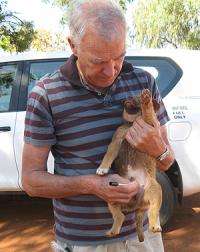Cattle parasite found throughout Australia, study finds

A parasite linked to dogs and responsible for an estimated $30 million loss to the national cattle industry each year is present throughout Australia, a University of Sydney study has revealed.
Previously this parasite was believed to be active only on the east coast of Australia and passed on mainly by domestic dogs. The new findings, published in the latest edition of Veterinary Parasitology, show other dog populations are infected and have important implications for vaccination development.
"The research also raises crucial questions about which other domestic and native animals could be affected by the parasite," said Dr. Jan Slapeta, the lead author of the study, from the Faculty of Veterinary Science.
The Neospora caninum parasite, passed from dogs to cattle, is carried in a dormant state in cows. When the cow becomes pregnant the parasite becomes active and can cause an abortion.
If instead the cow with the parasite has an apparently healthy female calf, the parasite can be silently passed on to that healthy animal and give it a much higher chance of aborting in its first few pregnancies.
Dogs become hosts to the parasite after eating infected meat (from a variety of animals).
"Until now abortions caused by Neospora caninum have been identified along the eastern coast of Australia and associated with domestic dogs known to harbour the parasite," said Dr. Graeme Brown, a senior author of the study, also from the Faculty of Veterinary Science.
"What we did for the first time was look at two other dog populations from across Australia - wild dogs and remote Aboriginal community dogs (which live in varying degrees of domestication). We found that both populations have a high degree of exposure."
Two important conclusions come from that result. The first is that the range of the parasite is not confined to the east coast of Australia but extends across the country, placing more of Australia's cattle market at risk than previously realized.
Secondly the presence of the parasite in wild dogs means Neospora caninum has a previously unrecognised ability to infect native wildlife. Its possible impact on Australian ecosystems is therefore unknown and likely to have been underestimated.
"Understanding the interactions of native wildlife, the cattle industry and dog populations will help our efforts to fight this infection. Most importantly this new knowledge about its distribution and agents can underpin the development of an effective vaccine," Dr. Brown said.
Provided by University of Sydney



















